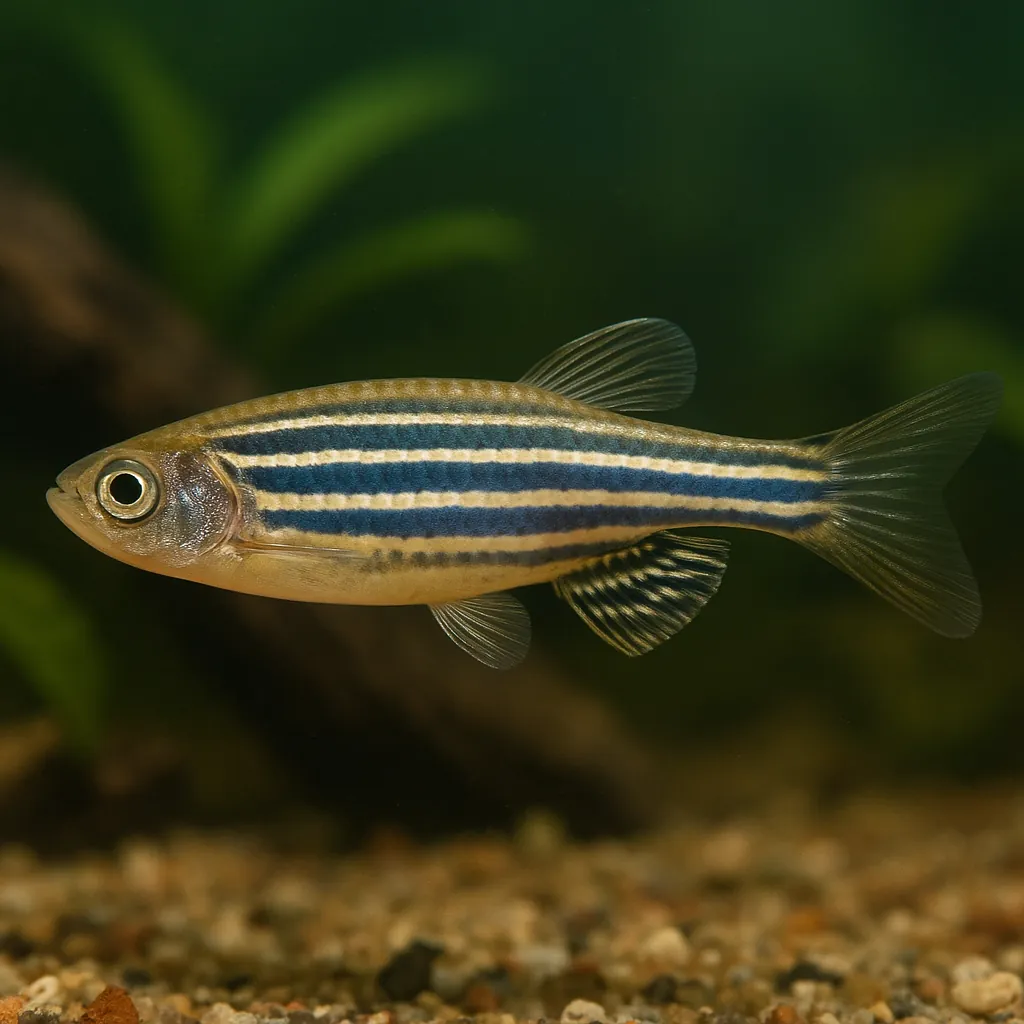
Zebra danio
Introduction
The Zebra Danio (Danio rerio), also known as the Striped Danio, is a popular choice among aquarists due to its striking horizontal stripes and lively behavior. These hardy fish are well-suited for both beginners and intermediate fishkeepers, offering a combination of resilience and active swimming patterns that add vibrancy to any freshwater aquarium.
What makes Zebra Danios appealing to aquarists?
Their hardiness and adaptability to various water conditions make them ideal for novice fishkeepers. Additionally, their active nature and schooling behavior provide dynamic movement in the tank.
Are Zebra Danios suitable for community tanks?
Yes, their peaceful temperament allows them to coexist harmoniously with a variety of other fish species, making them excellent candidates for community aquariums.
Care and Environment
Proper care for Zebra Danios involves attention to tank size, water parameters, filtration, lighting, feeding, and tank setup to ensure a healthy and stimulating environment.
What is the minimum tank size for Zebra Danios?
A minimum tank size of 37 liters is recommended to accommodate a small group of Zebra Danios, as they are active swimmers and thrive in schools.
What are the ideal water parameters for Zebra Danios?
Maintain a temperature between 18°C and 24°C, a pH range of 6.5 to 7.5, and water hardness between 5 to 12 dGH to replicate their natural habitat conditions.
How should the tank be set up for Zebra Danios?
Provide a well-planted tank with open swimming spaces. Use a dark substrate to enhance their coloration and include decorations like driftwood or rocks for hiding spots. Ensure the tank is securely covered, as Zebra Danios are known to jump.
What type of filtration and lighting do Zebra Danios require?
A quality filter that provides moderate water flow is essential to keep the water clean and oxygenated. Standard aquarium lighting is sufficient, but diffused light can be achieved with floating plants if needed.
What should be included in the diet of Zebra Danios?
As omnivores, they should be fed a varied diet including high-quality flake food, supplemented with live or frozen foods like bloodworms, brine shrimp, and daphnia to ensure optimal health.
Origin and Habitat
Zebra Danios are native to the freshwater streams and rivers of India, Bangladesh, Nepal, and Bhutan. They inhabit a variety of environments, from fast-flowing rivers to stagnant ponds, often found in areas with dense vegetation and sandy or pebbly substrates. These regions experience seasonal variations, with monsoon rains leading to changes in water flow and quality, which the Zebra Danios have adapted to over time.
Where are Zebra Danios originally from?
They originate from South Asia, specifically India, Bangladesh, Nepal, and Bhutan.
What type of natural habitats do Zebra Danios prefer?
They thrive in freshwater environments such as rivers, streams, and ponds with varying flow rates and abundant vegetation.
Temperament and Compatibility
Zebra Danios are peaceful, social fish that exhibit schooling behavior, making them ideal for community tanks. They should be kept in groups of at least six to prevent stress and promote natural behavior. Suitable tank mates include other small, non-aggressive species like Tetras, Guppies, and Corydoras Catfish. However, they may nip at the fins of slow-moving or long-finned fish, so it's advisable to avoid housing them with species like Angelfish or Betta Fish.
Are Zebra Danios aggressive?
Generally, they are peaceful but can exhibit fin-nipping behavior if not kept in adequate group sizes or if housed with incompatible tank mates.
What are suitable tank mates for Zebra Danios?
Compatible companions include Tetras, Guppies, Mollies, and Corydoras Catfish, all of which share similar temperaments and environmental requirements.
Interesting Facts
Zebra Danios are not only popular in the aquarium trade but also serve as important model organisms in scientific research due to their genetic similarity to humans and transparent embryos, which allow for easy observation of developmental processes. They are known for their rapid breeding cycle, with females capable of laying hundreds of eggs at a time. Additionally, their resilience and adaptability have led to their presence in a wide range of aquatic environments, from rice paddies to urban water bodies.
Why are Zebra Danios used in scientific research?
Their genetic makeup and transparent embryos make them valuable for studying developmental biology and genetics.
How prolific are Zebra Danios in breeding?
Females can lay hundreds of eggs per spawning event, contributing to their widespread presence in various aquatic habitats.
Sources
All information in this article has been gathered from the following reputable sources:
Overview
Recommended Tank Size 21.1 Gallons (for groups of 6 or more) |
Minimum Group Size 6 |
Minimum Tank Volume 9.8 Gallons |
Maximum Adult Length 2 inches |
Average Adult Length 1.6 inches |
Shoaling (6+ required) Yes |
Preferred Water Type Freshwater |
Temperature Range (°C) 18–24 |
pH Range 6.5–7.5 |
Water Hardness (dGH) 5–12 |
Typical Lifespan (years) 2 years |